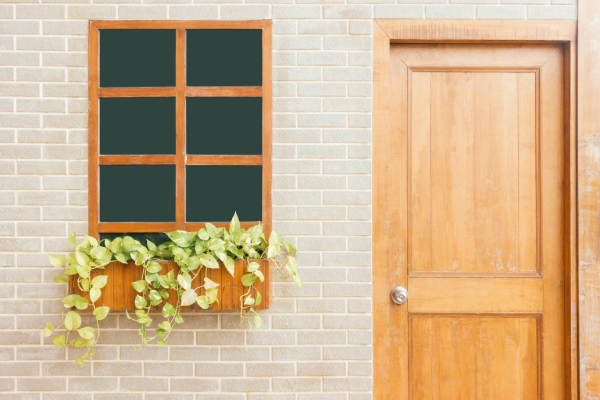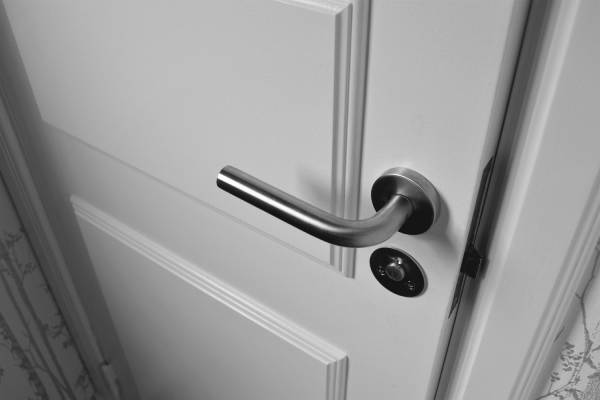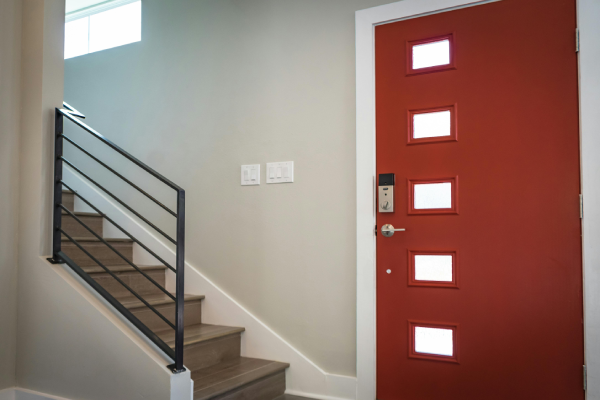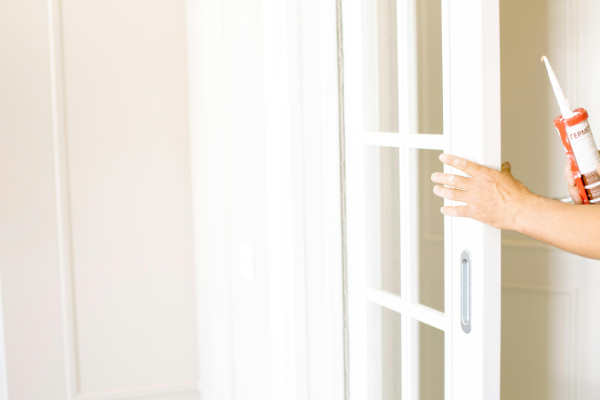
Your doors do more than just provide privacy and security — they contribute to your home’s energy efficiency, curb appeal, and overall functionality. But when a door starts acting up or showing signs of wear, homeowners are often left wondering: Should I repair it or replace it?
Knowing when to fix a door with a few simple adjustments and when it's time to invest in a new one can save you time, money, and energy in the long run. In this guide, we’ll walk you through the most common door problems and how to decide between door repair and door replacement.
Common Signs Your Door Needs Attention
When you notice an issue with one of your doors, it can be tricky to determine the best course of action. Identifying the specific problem is the first step toward deciding between a quick fix and a complete overhaul.
It Squeaks, Sticks, or Won’t Latch Properly
Noisy or hard-to-operate doors are often the first sign that something’s off. If your door squeaks loudly when opened or requires extra force to shut, you’re likely dealing with misaligned hinges, minor warping from seasonal moisture changes, or loose hardware. These are usually straightforward repairs. Tightening the hinges, realigning the strike plate, or lubricating the moving parts can often fix the problem quickly and affordably.
However, if your door seems to stick only during certain times of the year, like an unusually humid summer or a dry winter, it could mean the wood is expanding and contracting too much. Repeated seasonal swelling may point to more significant frame issues, especially if the sticking gets worse over time or you see visible gaps around the door.
You Feel Drafts or See Light Around the Edges
If you can feel cold air seeping in during the winter or see sunlight filtering in around the edges of your door, your home’s energy efficiency is likely taking a hit. Drafts often stem from an unsealed threshold or subtle frame movement caused by a settling foundation. These issues are common in Idaho homes, where shifting soil and extreme temperatures can subtly shift a door frame over the years.
Fortunately, this type of problem doesn’t always mean you need a new door. In many cases, sealing up the edges, installing new weatherstripping, or adjusting the threshold is enough to restore the door’s insulation. That said, if these fixes don’t solve the problem or if the frame has become noticeably warped, replacement may be the more efficient option in the long run.
Visible Damage or Structural Issues
Once a door starts showing signs of severe damage, repair becomes less practical. Cracks in the panel, soft or rotting wood, termite tracks, or water damage suggest long-term deterioration. This type of damage doesn’t just affect how the door looks; it can also jeopardize your home’s security, especially if the door can no longer latch securely or seal properly.
For exterior doors, in particular, structural damage can leave your home vulnerable to weather damage, pests, and intruders. When a door is compromised to that degree, replacing it is usually the best course of action. Not only will it restore your peace of mind, but a new, properly sealed door can also enhance your home’s curb appeal and improve energy efficiency year-round.

When Door Repair Is the Right Call
Not every door problem requires a full replacement. You resolve many issues with simple repairs that restore both function and appearance. If the door is generally in good shape, fixing specific problem areas is often the most practical and cost-effective option.
Minor Cosmetic Damage
Doors, particularly those in high-traffic areas or interior spaces, are prone to scuffs, scratches, and minor dents from frequent use. While these imperfections can be visually unappealing, they rarely compromise the door's structural integrity. Simple repairs such as paint touch-ups, light sanding to remove minor grooves, or complete surface refinishing can significantly enhance a door's aesthetic.
This is especially beneficial for sturdy, solid-wood doors, which often possess historical or architectural significance in older residences. Performing these minor repairs helps to maintain your home's unique character and prevents the expense of unnecessary replacements.
Loose Hinges or Hardware
If your door has started to sag, creak, or drift out of alignment, the culprit is often loose or failing hardware. Tightening the hinges or replacing worn-out screws and handles can dramatically improve how the door operates, often in just a matter of minutes.
In some cases, adding longer screws or adjusting the hinge position slightly will realign the door and eliminate gaps or sticking. These types of fixes are low-cost and highly effective, making repair the clear choice when the rest of the door is sound.
Worn Weatherstripping or Thresholds
Something as simple as degraded weatherstripping or a worn threshold can lead to drafts and temperature fluctuations in your home. These components naturally wear out over time, but replacing them is a straightforward way to improve comfort and energy efficiency.
Most weatherstripping replacements as well as replacing the door sweep takes less than one hour, and the materials are generally inexpensive. For homeowners trying to keep heating and cooling costs under control, restoring a proper seal around the door is an easy first step, often saving hundreds on your energy bill throughout the year.
When It’s Time for a Full Door Replacement
Sometimes, a repair just isn’t enough. If your door has extensive damage, outdated materials, or ongoing performance problems, replacement may be the smarter investment. While it may require a higher upfront cost, installing a new door can improve your home’s security, comfort, and even resale value.
Severe Structural Damage
When a door has deep cracks, significant wood rot, or rusted metal components, it’s usually beyond saving. An exterior door that can’t close properly or shows signs of softening due to moisture puts your security at risk. Even if some damage seems minor, once the core structure is compromised, the door loses its long-term durability, making replacement the safest and most reliable option.
Poor Insulation or Energy Efficiency
Older doors, especially those made of outdated materials, often lack the insulation needed to keep your home comfortable year-round. If you’re noticing consistent drafts or higher energy bills, your door could be part of the problem. Many modern entry doors have insulation built into the core and improved weather-sealing features. Upgrading to one of these newer models can help reduce utility costs while keeping your home more comfortable in both Idaho’s cold winters and hot, dry summers.
Repeated Repairs That Don’t Last
If you’ve already repaired a door multiple times and the same problems keep coming back, that’s a strong sign that the door or its frame may be permanently warped. Seasonal expansion, shifting foundations, or improper installation can all contribute to persistent issues with alignment and operation. At a certain point, continued repairs become more expensive and time-consuming than replacing the door altogether.
Replacing a door can also be an opportunity to adapt your home to suit your lifestyle better. For example, many homeowners choose to install wider doors to accommodate aging in place, accessibility needs, or a more open floor plan. Whether you’re remodeling or simply trying to make your home more functional, a new door installation can align with broader improvements to comfort and design.

How To Decide: Door Repair vs Replacement
Even when you know something’s wrong with your door, it’s not always easy to choose between a quick fix and a complete replacement. A few key considerations can help guide your decision and make sure you’re investing wisely in your home.
Assess the Age and Material of the Door
To decide whether you need to repair or replace your door, first figure out what material the door is. Different materials age differently, and some hold up better than others in Idaho’s climate. Here’s how the most common types compare:
- Wood doors: Classic and durable, but prone to swelling, warping, and cracking from moisture and temperature changes.
- Steel doors: Strong and weather-resistant, though vulnerable to dents and rust if the surface is damaged.
- Fiberglass doors: Lightweight and energy-efficient, but can crack or become brittle over time, especially from impact.
If your door is older, made from less durable materials, or showing multiple signs of wear, it may not be worth investing in more repairs. In many cases, a new door offers better energy performance, modern security features, and long-term peace of mind.
Compare Short-Term and Long-Term Costs
Homeowners often focus on the immediate price of a repair versus the upfront cost of a replacement, but they also need to consider long-term value. Minor repairs — like fixing a squeaky hinge or replacing weatherstripping — typically cost far less than a complete installation. However, if you’re facing repeated service calls, poor insulation, or visible deterioration, those small repair bills can quickly add up.
New door installations tend to range from a few hundred dollars for interior doors to over $1,000 for high-quality exterior models, depending on style, material, and labor. But these costs pay off over time. Energy-efficient doors can lower your utility bills, and upgraded entry doors may improve your home’s curb appeal and resale value. If you’re planning to stay in your home for years to come, consider the long game.
Consider the Purpose and Location of the Door
The decision to repair or replace a door largely depends on its location within your home.
Entry doors, for instance, are critical for security, insulation, and curb appeal. When these doors exhibit signs of wear, such as drafts, damage, or misalignment, replacement is often the most sensible option to ensure safety and energy efficiency.
Interior doors do not face the same external stressors. They are generally more straightforward and more cost-effective to repair or replace, making minor touch-ups and quick fixes a practical choice. You can resolve most cosmetic or alignment issues with interior doors with a brief repair appointment.

How Mr. Handyman Keeps Your Doors In Shape
Whether you’re dealing with a stubborn hinge, a warped frame, or a front door that’s seen better days, Mr. Handyman of Boise, Meridian, and Nampa is here to help. Our team brings expert craftsmanship and reliable service to every job, making sure your doors not only look great but also function safely and efficiently. We always aim to save you time, energy, and money by recommending the solution that makes the most sense for your home and budget.
From door repair services that take just a few hours to seamless door replacements that upgrade your home’s performance, we’re ready to help with every step of the process.
Don’t let that troublesome door keep bothering you — schedule your door repair or replacement with Mr. Handyman today!
FAQs About Door Repair And Replacement
How Much Does Door Repair Typically Cost?
Door repair costs vary depending on the issue, but most minor fixes—like tightening hinges, replacing weatherstripping, or adjusting the latch—range from $190 to $250. More involved repairs, such as fixing warped frames or replacing hardware, may cost up to $310. Labor and materials will affect the final price as well.
What Are the Signs I Need a New Door?
You may need a new door if you notice:
- Cracks, warping, or rot that compromise the structure
- Persistent drafts or difficulty closing the door
- Rust, corrosion, or moisture damage (especially on metal or wood doors)
These signs often point to irreversible damage that repairs won’t fix long-term.
Can I Just Replace the Door Without Changing the Frame?
Yes, if the door frame is still level, square, and in good condition, you can replace the door slab without replacing the entire frame. However, if the frame is warped, rotted, or misaligned, it’s often better to replace the entire unit to ensure proper function and fit.
How Long Should a Front Door Last?
The lifespan of a front door depends on its material and exposure to the elements:
- Wood doors: 20–30 years with regular maintenance
- Steel doors: 20–40 years, rust-resistant but prone to dents
- Fiberglass doors: 30–50 years, highly durable and energy-efficient
Routine upkeep and climate conditions can affect longevity.
Will Replacing My Front Door Increase Home Value?
Yes. A new front door can boost curb appeal, improve energy efficiency, and enhance security—all of which add to your home’s value. According to industry data, front door replacement projects often have one of the highest returns on investment for exterior upgrades.
Are There Energy-Efficient Doors That Help Lower Utility Bills?
Absolutely. Modern fiberglass and steel doors with insulated cores and tight weather seals help reduce air leaks and temperature loss. Look for ENERGY STAR® certified models when shopping for replacements to maximize savings and comfort.
